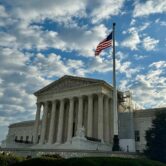SAN FRANCISCO (CN) – U.S. Supreme Court Associate Justice Neil Gorsuch urged a crowd of judges, justices and new citizens to “tolerate the cacophony of democracy” at an immigration swearing-in ceremony Monday evening, marking the end of the first day of the Ninth Circuit Judicial Conference.
“Democracy depends on every one of us to hear and respect even those we disagree with strongly,” Gorsuch told the group of new citizens, who immigrated from nations including Brazil, Argentina, Ireland and India.
“In a government by and for the people, we have to remember that those with whom we disagree even vehemently still have the best interests of the country at heart,” he continued. “We have to remember that democracy depends on our ability to reason and work with those who hold very different convictions and beliefs than our own. We have to learn not only to tolerate different points of view but to cherish them. To cherish the cacophony of democracy.”
As Gorsuch’s remarks seemed in answer to deep political divisions running through the United States, the Ninth Circuit’s annual conference – held in San Francisco since for the first time since 1973 – features an agenda that could be considered a riposte to some of the policies of President Donald Trump, whose executive orders on immigration have landed him in conflict with the powerful circuit that has jurisdiction over much of the western United States.
Later in the week, judges are scheduled to hear programs on fake news, distrust in the election process, the balance between privacy and technological advances in the law.
The conference’s opening day did not flinch at political subjects, as earlier in the afternoon judges heard an historical overview of three Supreme Court cases arising from the mass incarceration by executive order of 120,000 Japanese-Americans during World War II.
Three Japanese-Americans – Fred Korematsu, Gordon Hirabayashi and Minoru Yasui – defied their detention orders, and their legal challenges were rejected by the Supreme Court. It wasn’t until the cases were reopened in 1983 and the convictions set aside by writ of coram nobis, or writ of error, that the three men found vindication.
Dale Minami, a partner at the San Francisco firm Minami Tamaki, criticized the Supreme Court’s Korematsu decision for deferring to the executive branch and the military and using national security as justification. A discredited report submitted by Gen. John DeWitt to the high court said Japanese-Americans were committing espionage in droves.
“The court gave almost complete deference to the military, and they refused to look at any underlying facts in the justification for the incarceration,” Minami said. “The duty of the courts is to judge any decision by any person on constitutional law – nobody is above the constitution. Those issues are still relevant today, as we well know.”
In a video address, Ninth Circuit Judge Wallace Tashima called the Korematsu case one of the 10 worst decisions of the Supreme Court.
Tashima and his family were interned during World War II in Arizona, when he was only eight years old.
“The problem is if it happens once, it can happen again,” he said. “What all of us should do, particularly judges, is guard against those kinds of things. It’s the main reason I think I wanted to be a judge.”








